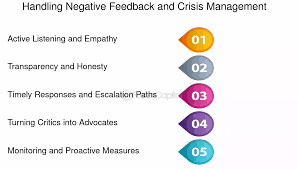“Feedback loops are bad” is generally the rule, but it turns out they sometimes can be good. In the age of everything-created-to-please-the customer, learning how to respond to negative feedback is a must-do if you want to make unhappy customers happy and improve your brand image.
This all-encompassing guide delves into proven methods to transform criticism into constructive insight that drives customer loyalty.

Why Negative Feedback Matters More Than Ever
Negative feedback, when handled properly, offers a goldmine of opportunities. According to a 2023 report by Qualtrics, 78% of customers are more likely to remain loyal to a brand that acknowledges and resolves their complaints promptly.
Here’s why negative feedback is vital:
- Reveals Gaps in Service or Product Quality
- Gives You a Competitive Edge
- Improves Trust and Transparency
- Boosts Brand Image Through Proactive Response
Instead of ignoring complaints, savvy businesses leverage them as data points for continuous improvement.
Understanding the Root of Customer Complaints
Before you can resolve issues, you must understand them. Negative feedback usually falls into categories like:
1. Product-Related Issues
These include defects, performance failures, or poor user experience. Common with tech or physical goods.
2. Service-Related Concerns
Delays, lack of responsiveness, or impolite staff can spark dissatisfaction.
3. Expectation Gaps
Sometimes, marketing overpromises. When customer expectations aren’t met, frustration follows.
Pro Tip: Use sentiment analysis tools like MonkeyLearn or Google NLP to categorize and quantify feedback at scale.
Step-by-Step: How to Handle Negative Feedback Effectively
1. Respond Quickly and Empathetically
Timeliness shows customers you care. Aim to respond within 24 hours. Empathy builds trust.
Example: “We’re truly sorry for your experience, John. We understand how frustrating it must be and we’d like to make it right.”
2. Acknowledge the Issue Without Getting Defensive
Avoid blame games. Accept responsibility when necessary.
Do: “Thank you for bringing this to our attention. We’ll look into this immediately.” Don’t: “This isn’t our fault—it’s the delivery company.”
3. Investigate and Take Action
Dig into the issue using CRM and analytics tools. Was it a one-time error or a systemic problem?
Use tools like:
- Zendesk for customer support tracking
- Salesforce for complaint categorization
- Google Forms or SurveyMonkey for feedback collection
4. Communicate Your Resolution Plan
Be transparent. Let customers know what steps are being taken.
“We’ve fixed the bug and are rolling out an update next week.”
5. Follow Up
After resolving the issue, follow up to ensure the customer is satisfied.
6. Log and Learn
Create a feedback loop. Use this input to train your team, refine processes, or improve the product.
Real-Time Monitoring: How AI and Data Analytics Enhance Feedback Handling
1. Predictive Analytics
AI can detect patterns and anticipate future complaints based on past data.
2. Chatbots for Instant Acknowledgment
Automated systems can handle initial responses, giving human agents time to resolve the issue thoroughly.
3. Sentiment Analysis
Tools like IBM Watson or Lexalytics identify negative sentiments early and route them to the right teams.
4. Performance Dashboards
Track CSAT (Customer Satisfaction Score), NPS (Net Promoter Score), and CES (Customer Effort Score) to measure and act on feedback effectively.
Empowering Your Team to Handle Feedback Professionally
1. Train Staff Regularly
Use role-playing exercises and customer journey simulations to help staff develop empathy and resolution skills.
2. Establish Clear Protocols
Create a standardized workflow for complaint handling to ensure consistency.
3. Encourage Internal Feedback Loops
Customer service reps often have unique insights. Let their voice shape the strategy.
The Long-Term Benefits of Handling Negative Feedback Well
When handled strategically, negative feedback leads to:
- Increased Customer Loyalty: Satisfied complainants are 70% more likely to become repeat customers (Harvard Business Review).
- Higher Brand Advocacy: Resolved complaints turn detractors into promoters.
- Improved Products and Services: Each piece of feedback contributes to business intelligence.
- Reduced Churn Rate: Addressing customer pain points lowers dropout rates.
Integrating Feedback into Your Sales and Marketing Strategy
1. Showcase Responsiveness as a USP
Customers prefer brands that listen. Use testimonials from resolved cases as proof points.
2. Use Feedback to Improve Sales Copy
Identify recurring complaints and address them preemptively in your marketing materials.
3. Leverage Automation for Rapid Response
Incorporate feedback triggers in your CRM to automate follow-ups and surveys.
4. Real-Time Analytics to Guide Sales Teams
Equip your sales force with dashboards showing common customer concerns empowering them to tailor conversations accordingly.
Turning Setbacks Into Comebacks
Dealing With Negative Feedback Isn’t Just Damage Control It’s Also Growth. With the proper mindset, tools and tactical approach, this complaint will turn each complaint into a building block to increased customer satisfaction, trust and long-term business.
In an age of AI and algorithms, human empathy and responsiveness matters more than ever. Leverage the The best of both worlds to not just satisfy but delight your customers – even when you’re screwing up.
FAQ: Handling Negative Feedback to Improve Customer Satisfaction
Q1: What’s the best way to respond to angry customer reviews?
Stay calm, acknowledge their frustration, apologize sincerely, and offer a resolution.
Q2: Should I delete negative feedback from public platforms?
Only if it’s spam or abusive. Genuine complaints should be addressed, not deleted.
Q3: How quickly should I respond to negative feedback?
Ideally within 24 hours. The faster, the better.
Q4: Can negative feedback ever be a good thing?
Absolutely. It helps you uncover issues, improve, and build stronger customer relationships.
Q5: How do I prevent negative feedback in the first place?
Be proactive: gather regular customer input, set realistic expectations, and ensure quality service.